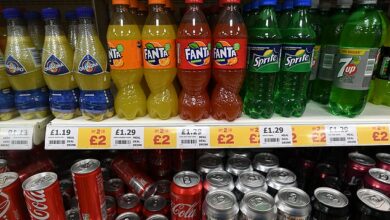Analysis reveals which fast food chains have the highest number of chemicals lurking in them
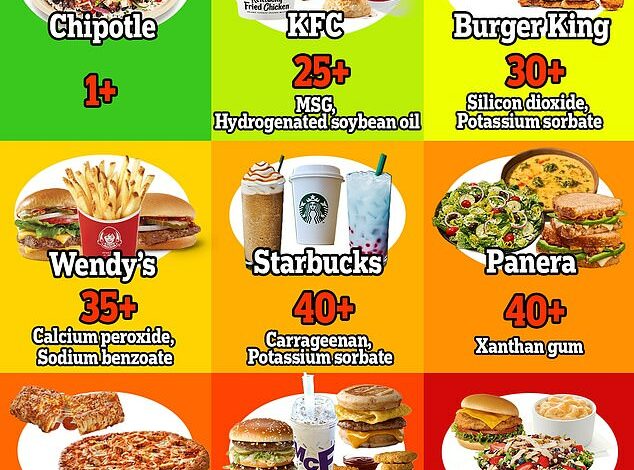

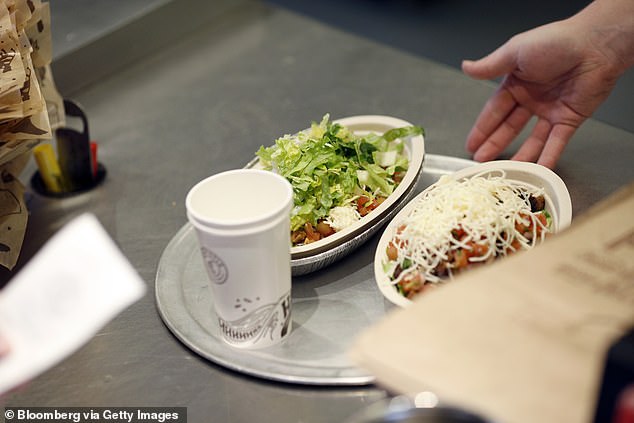
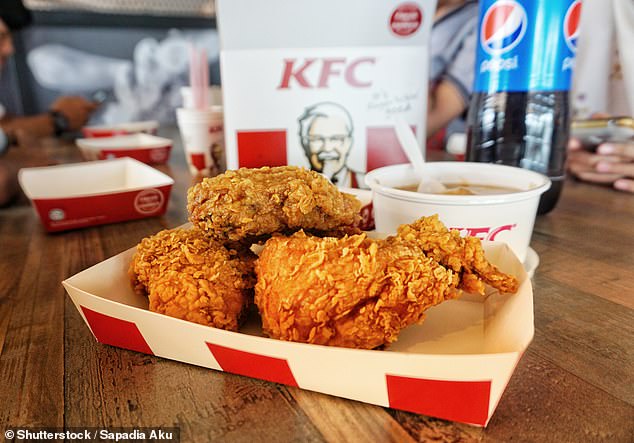


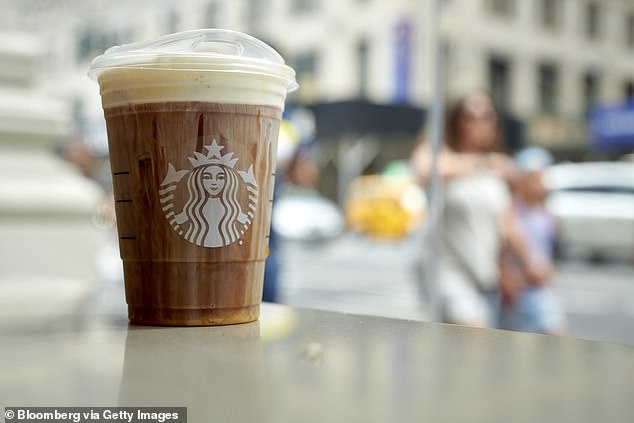




When it comes to your health, research is beginning to show it’s more complicated than calories in vs calories out.
Increasingly, scientists are learning that how much ultra-processed food someone eats has a bigger impact on whether they’ll be diagnosed with a disease or die young than previously thought.
There is still some debate around what is defined as ‘ultra processed’ – considered the most dangerous – and simply ‘processed,’ but many doctors advise sticking to foods that has fewer than five ingredients.
With this in mind, DailyMail.com has analyzed the ingredients lists of nine of the most-loved fast food items from chains across the US.

It reveals that, despite the calories being comparable with some of Americans’ guiltiest guilty pleasures, like chocolate or sweet treats, there are huge differences in the number of ingredients – between one and more than 60.
For comparison, a Hershey’s milk chocolate bar has eight ingredients, while Twizzlers candies have about a dozen ingredients.
And it’s not just the amount of ingredients, many of them are dangerous. Common among the long list are substances like dextrose, MSG, silicon dioxide and calcium peroxide.
These have been linked to inflammation, liver disease, weight gain, diabetes, asthma, digestive issues, DNA toxicity and damage to the immune system.
Chipotle

Chipotle’s ingredients aren’t harmful, but consumers should still be cognizant of how much they’re eating
Out of the nine chains DailyMail.com analyzed, Chipotle is seemingly the least processed.
It has a long line of food options – cheese, steak, beans and corn among them. In total, the brand has 52 ingredient options, including meats, cheese and salsas, as well as spices and herbs like peppers, salt and oregano
But each individual menu item available to customers – like Chipotle’s fajitas, carnitas or guacamole – has just a handful of those ingredients in it.
For example, Chipotle’s steak is meat, chili pepper and cumin and its tomato salsa is tomatoes, onions and salt.
So if a customer is craving a bowl with brown rice, black beans, cheese, lettuce and chicken, those are truly the only ingredients they are actually consuming – there are no preservatives, ultra-processed additives or unnecessary add-ins.
This is unlike other restaurants where cheeses or meats contain far more than their natural components.
As far as fast food choices, indulging in Chipotle isn’t the worst option.
But while the ingredients aren’t harmful themselves, consumers should still be cognizant of how much they’re eating.
Just one burrito can quickly add up to 1,600 calories – more than half of the recommended daily caloric intake.
KFC

KFC’s Original Recipe chicken is made with monosodium glutamate, better known as MSG
With ‘fried’ right in the name, it’s no surprise KFC’s chicken isn’t the healthiest option when you’re looking for a quick meal.
Its signature fried chicken may not contain as many ingredients as some others – about 10 – but the ones it does feature have been linked to detrimental health effects.
It’s Original Recipe chicken breast is made with monosodium glutamate, better known as MSG.
The over consumption of MSG has been linked to burning sensations in the neck and arms, flushing, dizziness, facial pressure, fainting, seizures and anxiety.
If consumed in extreme amounts, researchers have said MSG can act as a neurotoxin and lead to neurodegenerative conditions, though someone would have to consume – on its own – about six times the average amount found in most foods.
Because most foods do not contain a dangerous amount, the FDA considers MSG generally recognized as safe (GRAS).
And the chicken isn’t the only menu item with harmful additives lurking in it – KFC’s biscuit contains more than 25 ingredients, including palm oil, a vegetable oil that comes from the fruit of oil palm trees.
It is high in saturated fats, which can increase cholesterol and raise the risk of cardiovascular disease.
Some studies have suggested palm oil could be linked with certain types of cancers, heart disease and diabetes, but experts say more research into the association is needed as numerous studies have reported conflicting or inconclusive results.
The buttery and flaky food item also contains hydrogenated soybean oil. Hydrogenation creates trans fats, which have been associated with impaired blood sugar control and diabetes, inflammation and heart damage.
The good news at KFC, some of its vegetable sides, like corn and green beans, are single-ingredient dishes.
Burger King

Burger King’s Whopper contains silicon dioxide was found to significantly alter immune cell function in mice
There is no mistaking Burger King’s Whopper, with its fluffy bun, juicy beef patty and pickles.
But there are a few other things the iconic burger contains: silicon dioxide, potassium sorbate and soybean oil.
Of its 30-plus ingredients, these are just some that pose potential health risks.
Silicon dioxide is a natural compound that is used as an anticaking agent to prevent food from clumping.
The FDA has recognized the ingredient as generally safe, but the European Union Food Safety Authority has urged bloc leaders to impose stricter guidelines on the additive’s use in foods until more research has been on silicon dioxide’s effects in the human body.
A 2024 study from McMaster University found the ingredient significantly alters immune cell function. In mice, prolonged exposure to silicon dioxide was associated with damage to the gut lining and higher inflammation levels.
Researchers said chronic intake of the additive could contribute to digestive immune diseases, such as food allergies or celiac disease.
The FDA considers potassium sorbate safe to eat in small quantities, but one study said it could cause allergies, asthma, shortness of breath, headaches, chest pain and swelling of the airways.
And researchers at the University of California, Riverside found mice fed diets high in soybean oil had an overgrowth of harmful gut bacteria that raised their risk of developing colitis.
Wendy’s

Wendy’s Dave’s Single cheeseburger has more than 35 ingredients, including several that have been linked to harmful health effects
Famous for its red-headed mascot, Wendy’s has an extensive menu with items ranging from burgers and nuggets to fries, salads and desserts.
Its classic, the Dave’s Single, is packed high with a beef patty, cheese, onions and lettuce, along with ketchup and mayonnaise.
Less obvious, however, are the more than 35 ingredients hiding within it’s two stacked buns.
Among these is calcium peroxide.
Calcium peroxide is used in baking as a bleaching agent and is not approved for use in food in the EU, but the FDA considers it GRAS.
However, in significant quantities, the ingredient can cause gastrointestinal irritation and distress.
It also contains sodium benzoate as a preservative.
A major concern regarding this additive is its potential to be converted into benzene, a known carcinogen.
And several studies have suggested a link between sodium benzoate and cancer-promoting inflammation, ADHD, increased appetite, allergies and cell damage, which increases the risk of chronic diseases.
For anyone who has ever eaten a burger, they know it’s never complete without a side of French fries.
Wendy’s fries contain more than 12 ingredients, including hydrogenated soybean oil.
Starbucks

Popular Starbucks’ drink contain dozen of ingredients, including potentially harmful ones such as carrageenan
When you’re in need of a caffeine pick-me-up, a Starbucks is never far away. But you may want to think twice before you reach for the classic caramel Frappuccino, which contains more than 15 ingredients.
Among them is potassium sorbate, the ingredient found in the Burger King Whopper that can cause respiratory issues and headaches.
If coffee isn’t your thing and you’re looking for a tea fix, Starbucks’ Summer Skies Refresher may be appealing. The colorful drink contains more than 20 ingredients, including carrageenan.
Carrageenan is a plant-based food additive that comes from red seaweed. It is used to thicken or gel ingredients.
The FDA has approved the substance for use in food, but the National Organic Standards board voted to remove carrageenan from their approved list, meaning any product that contains the ingredient can no longer be labeled as organic.
One study found exposure to carrageenan was associated with intestinal ulcers and abnormal, potentially cancerous tissue growth.
Another study found similar results, with animals exposed to carrageenan developing ulcers and intestinal inflammation. The sores resembled features of those in humans with the chronic disease ulcerative colitis.
Additionally, the study subjects exposed to the ingredient experienced weight loss, anemia, diarrhea and bloody stools.
Panera

Panera’s Greek salad contains xanthan gum, an ingredient associated with excessive gas, diarrhea and intestinal complications in children
Known for its warm baguettes and creamy soups, Panera has an extensive menu ranging from salads and paninis to baked goods and pastries.
In several of its popular dishes, however, a potentially harmful ingredient is lurking.
In Panera’s bacon avocado melt, which has more than 35 ingredients, and the Greek salad, which has more than 40 ingredients, xanthan gum is listed as an ingredient.
Xanthan gum is a food additive found in thousands of products, from foods to toiletries to paints and herbicides. It is typically used as a thickening agent in food items.
While some studies have linked xanthan gum to health benefits, such as weight loss and lower cholesterol, others have reported the ingredient acts as a laxative, causing more frequent and looser stools, diarrhea, as well as excessive gas.
One set of researchers found consumption of xanthan gum led to an altered gut microbiome.
And when it was added to a baby food product, a study found children consuming it developed a life-threatening disease that caused their intestines to swell and die.
Domino’s

Domino’s pizza contained sodium propionate, which has been linked to pre diabetes and depression
Domino’s has some of the longest ingredient labels on the list, with popular items like its stuffed cheesy bread featuring more than 45 components.
And this menu staple contains several concerning additives, including hydrogenated soybean oil, the ingredient in KFC’s biscuit that is loaded with harmful trans fat.
Sodium propionate is also featured in the item. This ingredient is a food preservative and mold inhibitor the FDA declared is GRAS. However, research has revealed several harmful health outcomes associated with it.
One 2022 animal study found exposure to sodium propionate induced clinical symptoms of diabetes and disrupted the animal’s metabolism and how it processed glucose.
It also showed the animals exposed to the ingredient displayed depressive behavior and had higher levels of cortisol, the stress hormone.
An Australian study revealed a possible association between propionates and behavioral disorders in children, including ADHD, learning disabilities and sleep difficulties.
And a Harvard animal study found the ingredient can raise the risk of obesity and diabetes.
Sodium propionate is also found in Domino’s pizzas, along with sodium benzoate, the cancer-promoting ingredient used at Wendy’s that’s been linked to ADHD and cell damage.
A popular menu choice – the buffalo chicken pizza – contains more than 35 ingredients.
McDonald’s

McDonald’s menu items are full of dozens of potentially harmful ingredients, including xanthan gum, palm oil and dextrose
A McDonald’s Big Mac may arguably be the most famous fast food item. Estimates put the number of Big Macs sold every day at 2.4million across the globe.
This means millions of people are being exposed to the burger’s 60 plus ingredients, including xanthan gum and dextrose.
Dextrose is commonly used as a sweetener food additive. It is a simple sugar made from corn or wheat that acts in the body as glucose – or blood sugar.
It has been linked to liver abnormalities and can be especially dangerous in people who are at risk of or have diabetes because it can disrupt glucose levels and cause insulin resistance.
Insulin resistance causes the body’s cells to stop responding to the hormone insulin, which controls the amount of sugar in the blood. When sugar isn’t able to enter cells and builds up in the blood, it can lead to type 2 diabetes.
Dextrose is used in multiple foods at McDonald’s, including the breakfast item Sausage McGriddle.
And if you’re craving dessert from the golden arches and reach for a classic Oreo McFlurry, you’ll be consuming palm oil, which is high in saturated fats and can raise the risk of heart disease.
The sweet treat is made up of more than 20 ingredients.
Chick-fil-A

Several Chick-fil-A menu items contained more than 55 ingredients
Chick-fil-A may be the worst offender on DailyMail.com’s list. Of the several items we analyzed, including a children’s mc and cheese, a market salad and the classic chicken deluxe sandwich, they all had at least 55 ingredients.
Among them was sodium benzoate and maltodextrin.
Sodium benzoate is the preservative used by Wendy’s and Domino’s that has been linked to ADHD and cell damage.
And maltodextrin is used in foods as a preservative or thickener.
A 2015 study found people who consume maltodextrin had a reduced number of good bacteria in their gut and an increased number of bad bacteria, which could damage the intestines and raise the risk of inflammatory bowel conditions.
Another study showed the additive increases the activity of E. coli bacteria, which could raise the risk of Crohn’s disease.
And yet another linked maltodextrin to chronic inflammatory conditions and infection and inflammation of the digestive system.



